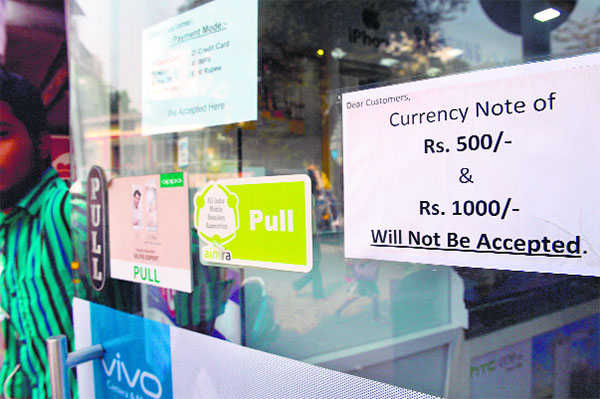
Two years on: On November 8, 2016, the government demonetised Rs 1,000 and Rs 500 banknotes.
Rajeev Jayaswal
Deputy Editor
Demonetisation is over, but its apparition remains. Even two years after the country's biggest currency coup, there is no absolute verdict about its efficacy and accomplishments. November 8, 2016 will be condemned by those who disapprove of any policy decision taken by the Narendra Modi government. Similarly, the move will be endorsed by a large section of politicians, policymakers and experts. A balanced approach is often elusive, mainly because analysts are not able to take a value-neutral position — businessmen and policymakers from within the system will refrain from criticising the government and independent-minded thinkers, under vigil of their peers, will not endorse any aspect of demonetisation without the risk of being branded as ‘bhakts’.
The truth lies somewhere between the two thoughts. Like a coin, demonetisation has two sides. The darker side of the exercise was the escape of the real offenders while the brighter one reflected in improved tax compliance.
There is no reason to disbelieve Finance Minister Arun Jaitley that the impact of demonetisation has been felt on the collection of personal income tax and corporate taxes, as they showed an about 20 per cent jump in the first seven months of the current financial year. He sees an overt trend in the income tax returns towards greater tax compliance, a 25 per cent growth with 6.86 crore tax returns filed in 2017-18. This is more than 80 per cent growth since May 2014 when the number of returns was 3.8 crore. Jaitley hopes to double this number by May next year, which is not a small feat.
The Finance Minister claims similar accomplishments in indirect tax collections. Even as he has cleverly mixed the impacts of both the demonetisation and subsequent GST implementation, credit must be given to the government, if both moves were the result of extensive planning and coordinated efforts. The indirect taxpayer base almost doubled: from 6.4 million taxpayers in the pre-GST regime to 12 million now. Jaitley's claim is praiseworthy: “Despite an annual income tax relief of Rs 97,000 crore given to the smaller taxpayers and a Rs 80,000-crore relief given to the GST assessees, tax collections have gone up. Rates of taxes, both direct and indirect, have been reduced, but tax collections have gone up. The tax base has been expanded. GST rates on 334 commodities which were paying an effective 31 per cent tax pre-GST have witnessed a tax reduction.”
There is some truth in the government's claim that demonetisation helped boost digitisation, but the target of creating a cashless economy is still elusive. Undoubtedly, demonetisation gave an impetus to the culture of electronic payment and strengthened compliance in the banking sector that included 'know your customer' (KYC) system beyond permanent account numbers (PANs). It also gave a boost to non-bank players such as Paytm. A number of telcos have joined the bandwagon after seeing huge business opportunities, and these payment banks are lobbying to get greater autonomy.
Like any other government, the incumbent is trying to justify its demonetisation decision. While some of its arguments are convincing, they are afterthoughts. It had initially told the nation that the aim of the exercise was to flush out black money from the economy, which ultimately turned out to be a colossal failure, as ways were found to return almost the entire Rs 15.41 lakh crore demonetised money to the banking system with the tag of legitimacy. The nation knows how people converted their black money into gold.
In November 2016, the government had taken the nation by surprise when it announced that Rs 1,000 and Rs 500 denomination banknotes would cease to be legal tender. Now, the people are puzzled that the mammoth exercise, which killed over 100 people standing in queues to exchange their hard-earned money, could unearth only Rs 13,000 crore. According to sources, the government had expected to discover black money worth around Rs 3 lakh crore. It was, however, based on a wrong premise. Still, it is surprising that more than 99.3 per cent of the demonetised notes were returned to the RBI vaults, and, possibly, it could add up to almost 100 per cent if we include the amount of demonetised Indian currency notes which are claimed to be held in neighbouring countries, such as Nepal. It seems that the country never had any black money or the entire black money has been laundered back into the system. A thorough probe is the only way to ascertain the truth.
The benefits of demonetisation are intangible and would be realised in the long term. But, its immediate impact on the economy is evident: it slowed the GDP rate by almost 1.5 per cent, with a notional loss of about Rs 2.25 lakh crore. While the big industries had felt a temporary headwind due to the demonetisation, a major impact was felt on the informal economy, the backbone of India with over 125 crore inhabitants, where only 1,40,139 taxpayers have an income of Rs 1 crore and more.
In the slugfest between the approvers and disapprovers of demonetisation, one crucial point is missed: the lesson to be learnt by this unprecedented policy move. It seems that the government has no intention to engage an experienced professional to audit the demonetisation exercise and come out with a white paper. Minister of State for Finance Arjun Ram Meghwal recently told the Lok Sabha that the government did not intend to conduct an audit on the impact of demonetisation. The debate over the efficacy of demonetisation is likely to continue for years till claims and counter-claims are backed by facts, provided by an able auditor such as the Comptroller and Auditor-General of India.




















